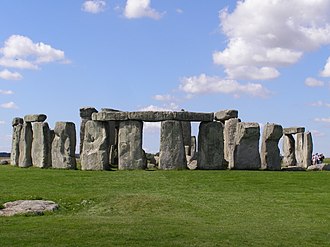Stonehenge




Stonehenge is a prehistoric monument located in Wiltshire, England, about 2 miles (3 km) west of Amesbury and 8 miles (13 km) north of Salisbury. It consists of a ring of standing stones, each around 13 feet (4.0 m) high, seven feet (2.1 m) wide, and weighing approximately 25 tons. The stones are set within earthworks in the middle of the most dense complex of Neolithic and Bronze Age monuments in England, including several hundred tumuli (burial mounds).
History[edit]
Stonehenge was built in several stages, with the earliest construction beginning around 3000 BC. The site evolved over a period of more than a thousand years, with the most significant construction phases occurring between 2600 BC and 2400 BC. The monument's purpose remains a subject of debate, but it is generally believed to have been used for ceremonial or religious purposes.
Construction[edit]
The construction of Stonehenge is a remarkable feat of engineering, given the technology available at the time. The stones were transported from distant locations, with the larger sarsen stones coming from the Marlborough Downs, about 20 miles (32 km) to the north, and the smaller bluestones from the Preseli Hills in Wales, over 150 miles (240 km) away. The exact methods used to transport and erect the stones remain a topic of research and speculation.
Phases of Construction[edit]
Stonehenge was constructed in several phases:
- Phase 1 (c. 3000 BC): The initial construction involved a circular earthwork enclosure, with a ditch and bank, and 56 pits known as the Aubrey Holes.
- Phase 2 (c. 2900 BC): Wooden posts were erected within the enclosure, possibly for ceremonial purposes.
- Phase 3 (c. 2600 BC - 2400 BC): The iconic stone circle was erected, with the sarsen stones forming a horseshoe shape and the bluestones arranged in a double arc.
Archaeological Significance[edit]
Stonehenge is one of the most famous landmarks in the United Kingdom and is considered a cultural icon. It is a UNESCO World Heritage Site and attracts over a million visitors each year. The site has been the subject of extensive archaeological research, which has provided insights into the lives of the people who built and used it.
Astronomical Alignments[edit]
One of the most intriguing aspects of Stonehenge is its alignment with celestial events. The monument is oriented towards the sunrise on the summer solstice and the sunset on the winter solstice. This has led to theories that Stonehenge was used as an ancient astronomical observatory or calendar.
Cultural Impact[edit]
Stonehenge has inspired countless myths and legends, including associations with Merlin and King Arthur. It has also been a site of modern cultural significance, serving as a gathering place for Druids and other groups during the solstices.
Also see[edit]
Template:Archaeological sites in the United Kingdom
Ad. Transform your life with W8MD's Budget GLP-1 injections from $75


W8MD offers a medical weight loss program to lose weight in Philadelphia. Our physician-supervised medical weight loss provides:
- Weight loss injections in NYC (generic and brand names):
- Zepbound / Mounjaro, Wegovy / Ozempic, Saxenda
- Most insurances accepted or discounted self-pay rates. We will obtain insurance prior authorizations if needed.
- Generic GLP1 weight loss injections from $75 for the starting dose.
- Also offer prescription weight loss medications including Phentermine, Qsymia, Diethylpropion, Contrave etc.
NYC weight loss doctor appointmentsNYC weight loss doctor appointments
Start your NYC weight loss journey today at our NYC medical weight loss and Philadelphia medical weight loss clinics.
- Call 718-946-5500 to lose weight in NYC or for medical weight loss in Philadelphia 215-676-2334.
- Tags:NYC medical weight loss, Philadelphia lose weight Zepbound NYC, Budget GLP1 weight loss injections, Wegovy Philadelphia, Wegovy NYC, Philadelphia medical weight loss, Brookly weight loss and Wegovy NYC
|
WikiMD's Wellness Encyclopedia |
| Let Food Be Thy Medicine Medicine Thy Food - Hippocrates |
Medical Disclaimer: WikiMD is not a substitute for professional medical advice. The information on WikiMD is provided as an information resource only, may be incorrect, outdated or misleading, and is not to be used or relied on for any diagnostic or treatment purposes. Please consult your health care provider before making any healthcare decisions or for guidance about a specific medical condition. WikiMD expressly disclaims responsibility, and shall have no liability, for any damages, loss, injury, or liability whatsoever suffered as a result of your reliance on the information contained in this site. By visiting this site you agree to the foregoing terms and conditions, which may from time to time be changed or supplemented by WikiMD. If you do not agree to the foregoing terms and conditions, you should not enter or use this site. See full disclaimer.
Credits:Most images are courtesy of Wikimedia commons, and templates, categories Wikipedia, licensed under CC BY SA or similar.
Translate this page: - East Asian
中文,
日本,
한국어,
South Asian
हिन्दी,
தமிழ்,
తెలుగు,
Urdu,
ಕನ್ನಡ,
Southeast Asian
Indonesian,
Vietnamese,
Thai,
မြန်မာဘာသာ,
বাংলা
European
español,
Deutsch,
français,
Greek,
português do Brasil,
polski,
română,
русский,
Nederlands,
norsk,
svenska,
suomi,
Italian
Middle Eastern & African
عربى,
Turkish,
Persian,
Hebrew,
Afrikaans,
isiZulu,
Kiswahili,
Other
Bulgarian,
Hungarian,
Czech,
Swedish,
മലയാളം,
मराठी,
ਪੰਜਾਬੀ,
ગુજરાતી,
Portuguese,
Ukrainian